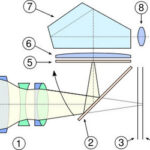Introduction:
This lab aims to familiarize us with the three types of spectra in astronomers use, the tools to find those spectra, and the, “Relationship between the colors of light and the wavelengths of the radiation producing those colors.” Stereoscopy, the splitting of light/radiation into component parts can show astronomers what celestial bodies are composed of and the motions of those bodies. Through extensive experimentation and observation Kirchoff devised his “Three Laws of Spectral Analysis” that correspond with the three types of spectra.
Procedure:
Using a prism, a demonstration will be set up using a slit in a slide projector that will be analyzed.
Diffraction grating will be used for the next experiments. For the continuous spectrum experiment (B1), the light from a light bulb will be examined through diffraction grating and the observations will be analyzed.
For the Bright Line Emission Spectra experiment (B2), high voltage gas filled tubes will be used. Mount the hydrogen tube in the power supply, turn it on, and line it up with the slit of the spectrometer. Look into the instrument and analyze the observations made.
For the final Absorption Spectrum experiment (B3), we will be provided with 2 glass filters that demonstrate absorption. One is didymium glass, and the other show broad absorption. Record and analyze those observations.
Data:
THE PRISM: The type of Kirchoff spectra I see is illustrated in Kirchoff’s first law of spectral analysis: “If a solid or liquid, or even a dense gas is heated to incandescence , it radiates a continuous spectrum, that is, a solid band of colors like a rainbow, ranging from violet at one end through blue, green, and yellow to red at the other end.” The source of light was an incandescent light bulb. It is logical that this would create a continuous spectrum because in a light bulb a solid (the filament) is heated to incandescence, so following Kirchoff’s first law it should make a continuous spectrum.
The order of colors that I saw are as follows: Red, orange, yellow, green, blue, indigo, violet. The color refracted most by the prism was violet. The color bent the least was red. Some colors at one end of the spectrum are compressed and others at the other end are spread out; this is what is known as an irrational spectrum. Grating is used to create rational spectrums as opposed to prisms.
THE CONTINUOUS SPECTRUM: The color bent the most by the grating was red. The color bent the least was violet. This is the opposite of what I observed from the prism. The shortest wavelength of light I was able to see was in violet in the 400nm-450nm range. The longest wavelength I was able to see was red extending all the way to the 700nm range of the spectrum. The human eye is most sensitive at about 555nm which contains the color green/blue. Human eyes may have evolved this way because a great deal of the natural environment that we interact in is green or blue.
Relative to the wavelength scale, ultraviolet radiation would be located to the left of violet, infrared to the right of red.
BRIGHT LINE EMISSION SPECTRA: I was able to observe three lines.
The wavelengths of my lines were roughly 460nm for H alpha, 495nm for H beta, and 665nm for H y. I did a fairly accurate estimate of the true wavelengths of the lines. I found that I don’t have good enough vision to see the fourth line of the Balmer series, so I cannot estimate its wavelength. There is not noticeable relationship between the color of the tube and the color that showed the brightest line. The tube glowed purple, while the brightest line that I observed was red. This suggests that glowing masses of gas in the galaxy like the Orion Nebula show as red because they are filled with Hydrogen which has its brightest color as red.
The mystery gas glowed orange in our tube. There were 8 lines on the spectrum.
Using the posters with comparison spectra provided, I determined that the gas in the tube was most likely helium gas.
ABSORPTION SPECTRUM: After both filters were placed in front of the spectrometer, I identified the didymium glass as the one that made this spectrum with absorption bands between roughly 560nm-690nm.
When the other filter was placed over the spectrometer, all of the spectrum up to 565nm was absorbed. The glass’ pass-band, the region of the spectrum it transmits, is 565nm-700nm (roughly yellow to red)
Error Analysis:
Error in this experiment could come from faulty instruments, in this case the grating spectrometer and our eyes. The grating spectrometer had a built-in ruler, but a ruler can measure the amount of units accurately enough to get a precise measurement. Along with the rulers, our eyes played a major factor in the observations. Everyone sees objects differently, and has different qualities of vision and placing colors in exactly the same place as others do. Colors are subjective which also adds to the experiments.
Conclusion:
This lab aims to familiarize us with the three types of spectra in astronomers use, the tools to find those spectra, and the, “Relationship between the colors of light and the wavelengths of the radiation producing those colors.” We took various observations from several different experiments using prism, diffration grating, and the spectrometers. I observed Kirchoff’s first rule of spectra in action during the prism experiment. In the first continuous spectrum experiment, the shortest wavelength of light I was able to see was in violet in the 400nm-450nm range. The longest wavelength I was able to see was red extending all the way to the 700nm range of the spectrum. During the bright line emission spectra experiment, I found the wavelengths of Hydrogen lines to be roughly 460nm for H alpha, 495nm for H beta, and 665nm for H y. Through the absorption spectra and emission spectra experiments, I learned how to use comparison spectra to derive information from spectra observations.



